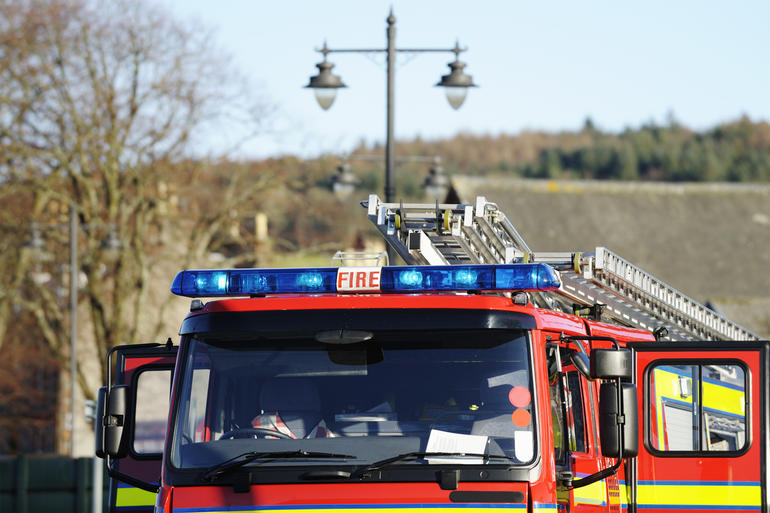
It has never been more important to protect people and property from the risk of fire. Whether your property is residential, commercial or public, the responsibility of fire prevention is primarily the property owner’s.
Are fires becoming more likely?
According to the UK Home Office, Fire & Rescue (F&R) services attended over 182,000 fires in the year ending March 2019. This is a worrying increase of 9% compared with the previous year.
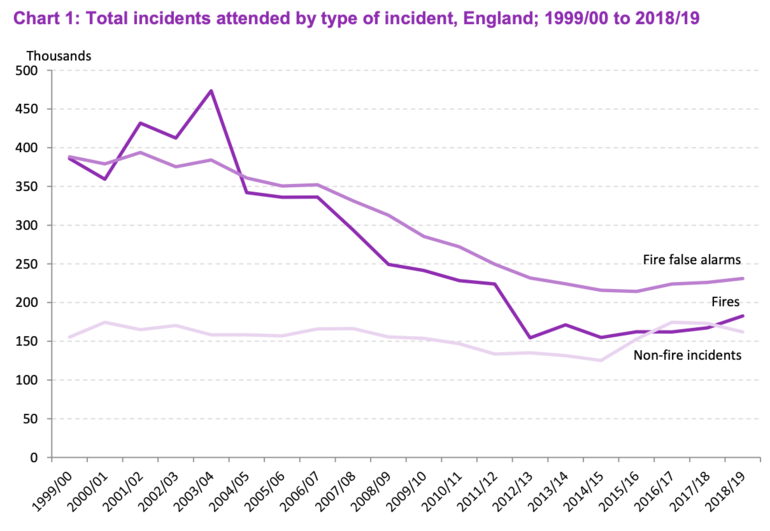
Source: UK Home Office
Since the last peak of 2003/04, the number of fires, fire related false alarms and non fire incidents attended by UK Fire & Rescue Services has been on a steady decline. That was until 2014/15, when incidents started climbing once again.
The Home Office states that “the increase in fire incidents from 2014/15 to 2018/19 was due to an increase in secondary fires linked to the hot, dry summer of 2018.”
What are primary and secondary fires?
Primary fires are defined as more serious fires that harm people or cause property damage; to be classified as a primary fire, an incident must meet at least one of the following criteria:
- Primary fires occur in non-derelict buildings, vehicles or other outdoor structures.
- Primary fires involve fatalities, casualties or rescues.
- Primary fires are attended by five or more pumping appliances (used by the fire service in putting fires out).
Primary fires include dwelling fires (such as places of residence, caravans and other residential accommodation), other buildings, such as care homes, hotels, hostels, offices, factories and restaurants. They also include road vehicle fires involving cars, vans, buses, lorries, etc.
Secondary fires, by comparison, are generally smaller outdoor fires that do not involve people or property. Common secondary fires include grassland fires, derelict buildings, refuse fires and other incidents that do not involve people.
With fire incidents on the rise once again, the time to safeguard your property and ensure you are meeting the latest fire safety standards is now. This guide will take you through some essential fire tips that you must not ignore.
1. Install Fire Doors where appropriate
Internal fire doors save lives. They are specialist doors that are designed and rigorously tested to withstand fire and prevent it from spreading around a property for as long as possible.
What is a fire door?
Fire doors feature crucial safety features which allow them to perform their jobs correctly - check out our detailed diagram below for more information.
Each Fire Door is rated - these ratings tell you how long a fire door can withstand the spread of fire. For example an FD30 fire door can withstand the spread of fire for 30 minutes, while an FD60 fire door can do the same for 60 minutes.
Below is a detailed diagram showing you some crucial features of a Fire Door.
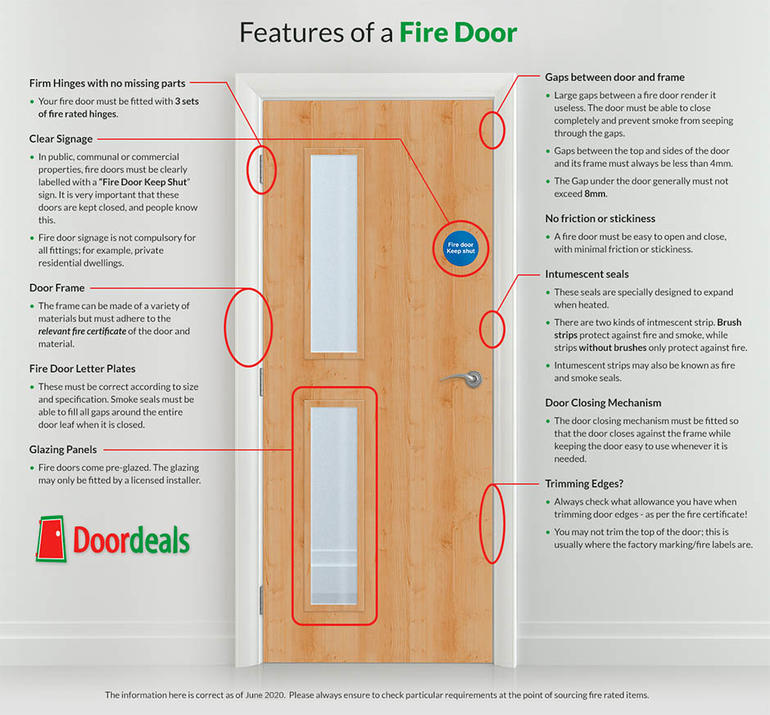
Do you need a fire door in your property?
If you are a residential homeowner, you will only be required to install fire doors if your home meets one of the following criteria:
- Your building is two-storeys and has a door leading from an internal garage into the house itself.
- Your building is a new build or renovated house with three storeys or more. You must have fire doors installed between every habitable room (bedrooms, not bathrooms) and the stairwell.
While you are not legally required to install fire doors in your home that does not meet the above criteria, some homeowners choose to install them internally for their safety benefits anyway.
If you own or are responsible for a public building, place of work or other non-residential property, strict fire regulations will apply to your building, including the installation of appropriate fire doors. You can find out more information on which regulations are applicable to your building through Government resources, such as the London Fire Brigade.
2. Ensure your smoke alarms are working and correctly placed
For something so critical for the fire safety of a building, there is a lot that can go wrong with a smoke alarm. According to the UK government, of all faulty or non-working smoke alarms:
- 10% had missing or defective batteries.
- 4% had faulty systems or were installed incorrectly.
- A massive 45% were not positioned adequately to cover potential sources of fire.
This is important because it shows that a smoke alarm installed correctly with no faults and fresh batteries can still be inadequate if not positioned correctly within the property.
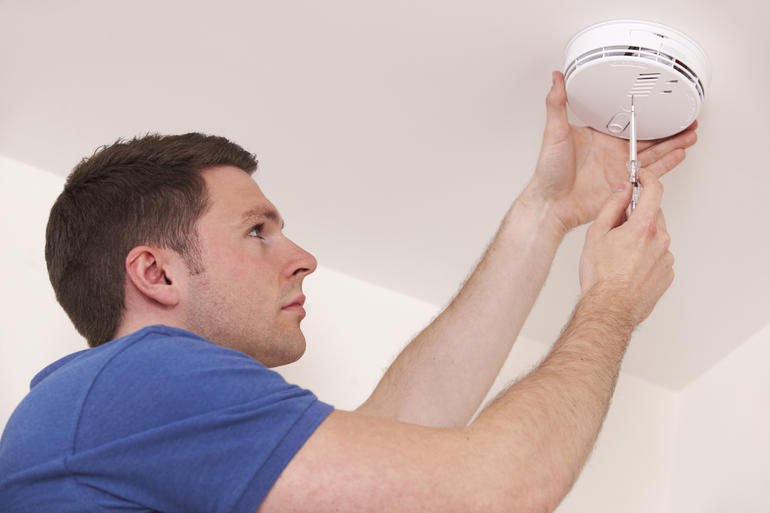
Where should a smoke alarm be placed?
Smoke alarms must be fitted in an appropriate location for them to be effective. They should be fitted as close to the centre of a room as possible, and at least a foot away from any wall or lighting fixture.
Smoke alarms must be installed in a place where they can be heard loud and clear throughout the property, especially at nighttime.
The National Fire Protection Association recommends that at least one smoke alarm is placed on every level of the home, including the basement.
Avoid placing smoke alarms in humid or moist areas, such as bathrooms, near ceiling fans or air vents, in non-temperature regulated garages, or in areas that collect lots of dirt or dust. All of these can prevent the alarm from detecting smoke effectively.
For further information on how smoke alarms must be installed in residential, commercial and public properties, consult the UK Government’s official guidelines.
3. Ensure your electrical appliances are safely installed and have been safety tested
Modern properties contain more electrical appliances and devices than ever before, so it’s never been more important to ensure everything is safe, tested and not a fire risk.
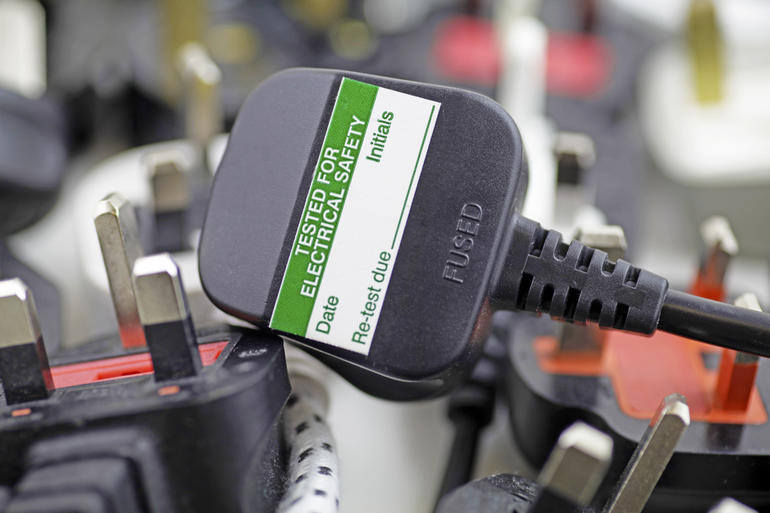
Having electrical appliances PAT (Portable Appliance Testing) tested is important to ensure the electrical components are safe to use. Not all electrical defects are visible.
New appliances and electrical equipment should be supplied in a safe working condition and does not require a PAT test. Nonetheless, regular visual checks are recommended in order to detect damage or other issues.
Testing electrical appliances in the home
For residential properties, getting electrical equipment PAT tested is at the discretion of the homeowner and is not a regular legal requirement. That said, getting your electrical appliances PAT tested can offer you peace of mind and legal protection, and hiring a professional is usually a quicker, safer option to testing appliances yourself.
Testing electrical appliances in public buildings or workplaces
If you are responsible for a public property, workplace or rental property, it is a legal requirement that electrical appliances are PAT tested. This includes landlords, employers and even self-employed individuals.
Other tips for electrical appliance safety
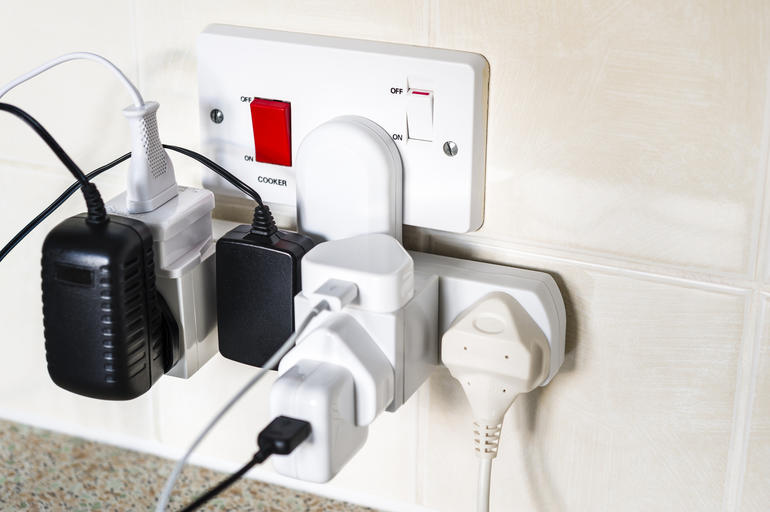
- Don’t plug too many appliances into a single socket.
- Have your new electrical installation checked by a registered electrician - this should be done every 10 years for an average home, or every 5 years for a private rental.
- Fit your fuse box with a Residual Current Device (RCD) - This switches electricity off automatically whenever a fault is detected.
- Always check cables for damage, wear and tear. Alway replace cables and plugs if there is even a slight hint of damage.
4. Do Not Smoke Indoors!
This one is very simple indeed. According to the London Fire Brigade, 6.3% of all fires are smoking related. Worse still, 26% of all fire related fatalities are related to smoking.
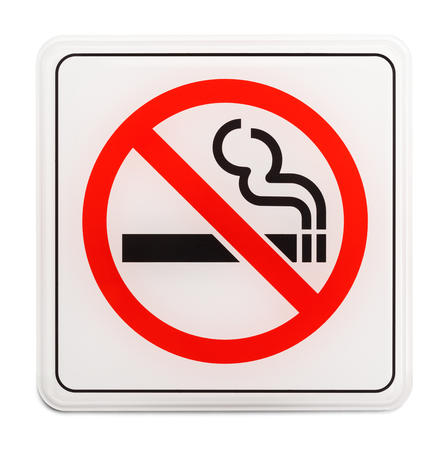
Smoking indoors greatly increases the risk of fire. The best way to mitigate this risk is simply to refrain from smoking; however, according to the LFB, the following tips can also help.
- Keep all ignition sources (matches, lighters, etc), out of the reach of children.
- Never smoke in bed and avoid smoking on any upholstery, especially if there is a chance you may fall asleep.
- Use proper ashtrays and always stub out cigarettes properly.
- Do not leave lit cigarettes, cigars or other tobacco products unattended.
- Ensure lit cigarettes or other tobacco products are stable - do not balance on ashtray edges or prop up against anything.
- When emptying ashtrays, ensure the ashes are cold and preferably wet before disposing. Never dispose of ashes in a waste paper bin.
Can Electronic Cigarettes create fire risks?
The London Fire Brigade considers electronic cigarettes a much better option than cigarettes from a fire safety perspective.
Like any electrical equipment, however, electronic cigarettes can pose fire risks if not used, stored or charged safely. To reduce these risks, never use a damaged or faulty e-cigarette, do not vape in close proximity to any flammables, and avoid leaving your electronic cigarette on charge overnight.
5. Be aware of all potential ignition sources in your property
An ignition source is anything that can produce sparks or sufficient heat to ignite flammable items. You should always be aware of all potential sources of ignition in the home, and ensure these are placed well away from any flammable objects.
Potential sources of ignition in the home, workplace or other building include:
- Smoking materials, including matches and lighters.
- Electric or gas heaters.
- Cooking equipment or appliances.
- Any electrical equipment.
- Naked flames or embers, such as candles or incense sticks.
- Any equipment used for “hot processes”, such as ironing, tools, glue guns, etc.
6. Prevent build up of dust
Household dust is a combustible that you may not think about regularly enough. Should combustible dust build up around plug sockets, electrical components or heaters, it can pose a significant risk of fire if exposed to heat sources for a prolonged period.
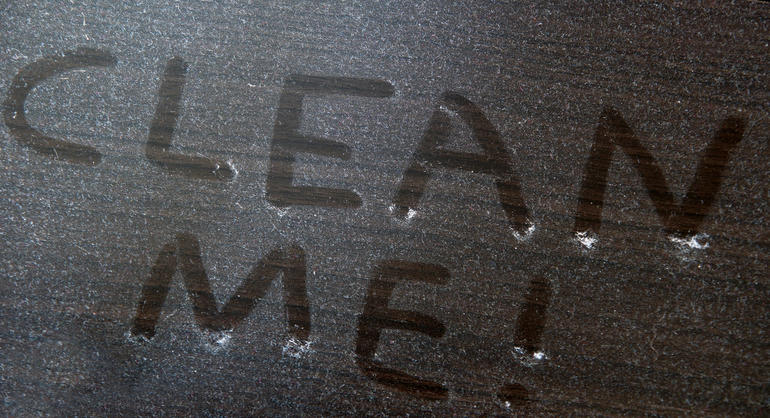
The good news is that dust is a potential fire risk that is very easy to take care of. By dusting and vacuuming your property regularly, with special care given to the above areas, you can significantly reduce the odds of particles igniting and causing a fire.
7. Keep downstairs internal doors closed
This one is less obvious but could make all the difference in the event of a fire. Even if they are not fire doors, a closed internal door (especially if you have solid internal doors) will help slow the spread of fire.
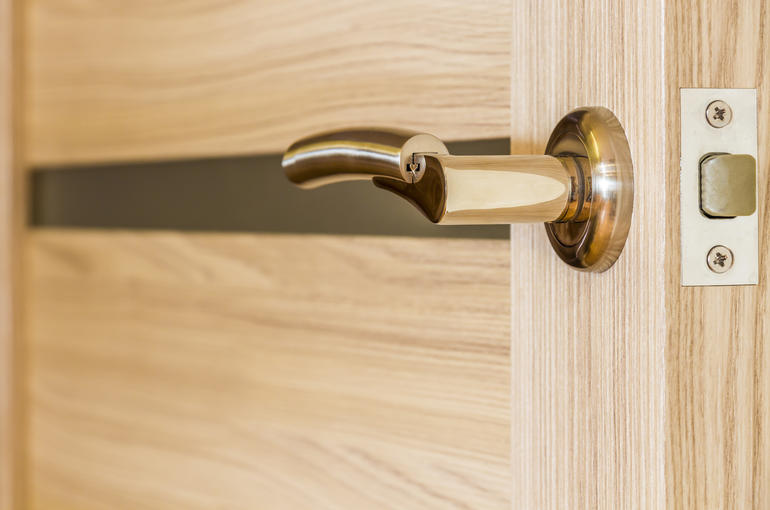
They would not halt the spread of fire like tested FD30 or FD60 Fire Doors would, but closed doors will still buy you a number of minutes to make a safe exit of the building.
Keeping your doors closed when not in use also prevents draughts and heat loss, and can help reduce your heating bills, so it’s certainly a good idea!
8. Keep combustibles away from heaters and other ignition sources
Combustibles are commonplace in any home, workplace or any other building type. At any given time, you probably have several combustibles in each room. This doesn’t mean your rooms are a blaze waiting to happen, but it helps to be aware of what combustibles you have, and where they are situated in relation to heaters and other potential ignition sources.

Common combustibles
- Aerosol cans
- Nail polish & remover
- Hand sanitizer
- Paint thinner
- E-Liquid
- Oranges (that’s right, oranges are highly flammable!)
- Flour
- Shoe polish
By ensuring these items are stored away from potential ignition sources (such as those listed in point 5), you can help reduce the risk of a fire breaking out (or worsening should one occur).
9. Stop the build up of oil and grime
Nobody likes cleaning the oven, but the importance of this pesky chore goes beyond hygiene and the flavour of your cooking. Burned food, grime and grease, if allowed to build up over time, can present a fire hazard.
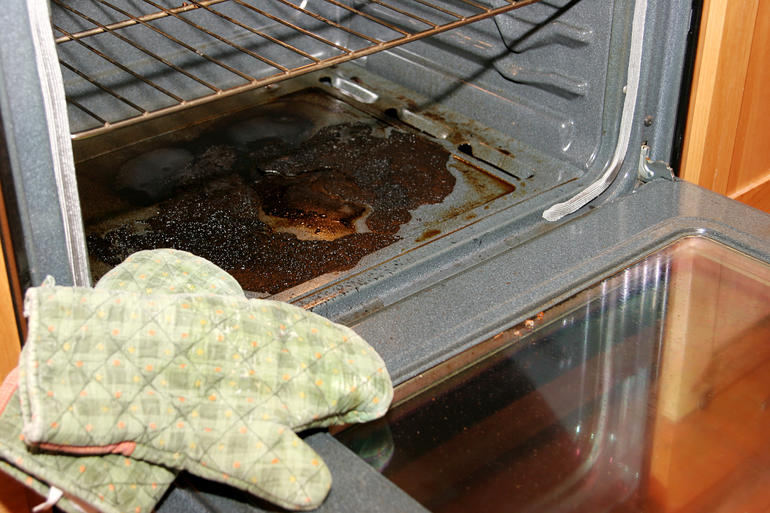
When bits of food and grease gets burnt onto the inside of your oven, this will continue to burn each subsequent time you use the oven. An easy way to recognise this issue (besides seeing the burnt food and grime) is if smoke comes from the oven when you open the door.
There are plenty of benefits of a clean oven, but fire safety is one of the most important reasons to keep it clean.
10. Do you have an old or faulty boiler?
A faulty boiler can cause all kinds of problems in the home, including issues with hot water and central heating. In some cases, though, an old or faulty boiler can pose a greater danger.
Old fire and back boilers, old floor standing boilers and open flued appliances do not have the same safety devices as most modern, room sealed boilers. These devices include thermostats, overheat stats, oxygen depletion sensors and pressure relief valves.
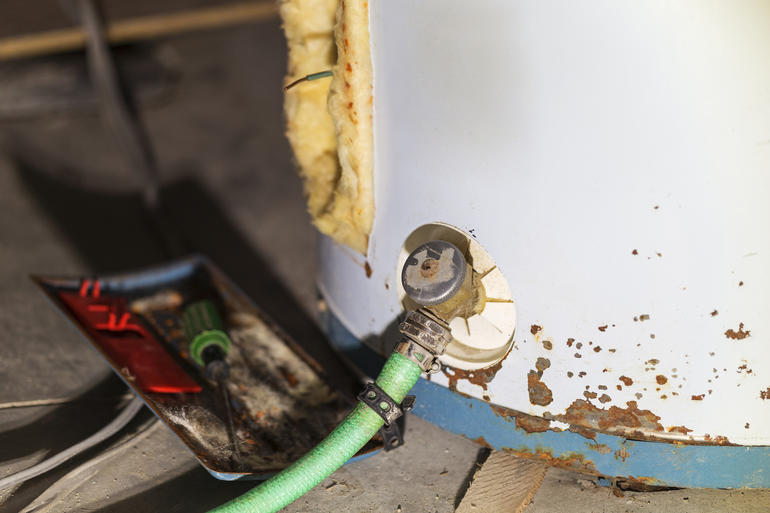
If your boiler is serviced annually, any danger will be at a minimum, but here are some signs that your old boiler may present potential fire or other hazards.
- Visible signs of scorching, sooting or black spillages.
- Smelling gas or fumes.
- Observing a yellow flame in the boiler.
- Any frequent symptoms, such as headaches or nausea, when the boiler is active.
If you have any doubts whatsoever on the health of your boiler, you should always consult a professional boiler engineer.
Keep your building safe
By understanding the potential causes of residential, commercial or public building fires, you will be better equipped to anticipate and prevent such incidents from happening.
If you have any doubts or wish to gain more information on fire safety, including any of the points mentioned in this article, please consult the UK Government’s Fire Safety Guidance or your local fire department for advice.
